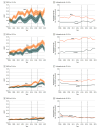Changes in Incident Schizophrenia Diagnoses Associated With Cannabis Use Disorder After Cannabis Legalization
- PMID: 39903464
- PMCID: PMC11795325
- DOI: 10.1001/jamanetworkopen.2024.57868
Changes in Incident Schizophrenia Diagnoses Associated With Cannabis Use Disorder After Cannabis Legalization
Abstract
Importance: Despite public health concerns that cannabis legalization may increase the number of cases of schizophrenia caused by cannabis, there is limited evidence on this topic.
Objective: To examine changes in the population-attributable risk fraction (PARF) for cannabis use disorder (CUD) associated with schizophrenia after liberalization of medical cannabis and legalization of nonmedical cannabis in Canada.
Design, setting, and participants: This population-based cohort study was conducted in Ontario, Canada, from January 1, 2006, to December 31, 2022, among 13 588 681 people aged 14 to 65 years without a history of schizophrenia.
Exposures: Diagnosis of CUD in the emergency department or hospital setting (International Statistical Classification of Diseases and Related Health Problems, Tenth Revision, Canada [ICD-10-CA] codes F12x and T40.7).
Main outcome and measures: Changes in the PARF for CUD associated with schizophrenia (ICD-10-CA codes F20x and F25x and Diagnostic and Statistical Manual of Mental Disorders [Fourth Edition] [DSM-IV] code 295x) over 3 policy periods: prelegalization (January 2006 to November 2015), liberalization of medical and nonmedical cannabis (December 2015 to September 2018), and legalization of nonmedical cannabis (October 2018 to December 2022). A secondary outcome was diagnosis of psychosis not otherwise specified (NOS) (ICD-10-CA code F29x and DSM-IV code 298x). Segmented linear regression was used to examine changes after the liberalization of medical cannabis in 2015 and the legalization of nonmedical cannabis in 2018.
Results: The study included 13 588 681 individuals (mean [SD] age, 39.3 [16.1] years; 6 804 906 males [50.1%]), of whom 118 650 (0.9%) had CUD. A total of 91 106 individuals (0.7%) developed schizophrenia (80 523 of 13 470 031 [0.6%] in the general population without CUD vs 10 583 of 118 650 [8.9%] with CUD). The PARF for CUD associated with schizophrenia almost tripled from 3.7% (95% CI, 2.7%-4.7%) during the prelegalization period to 10.3% (95% CI, 8.9%-11.7%) during the legalization period. The PARF in the postlegalization period ranged from 18.9% (95% CI, 16.8%-21.0%) among males aged 19 to 24 years to 1.8% (95% CI, 1.1%-2.6%) among females aged 45 to 65 years. The annual incidence of schizophrenia was stable over time, while the incidence of psychosis NOS increased from 30.0 to 55.1 per 100 000 individuals (83.7%) in the postlegalization period relative to the prelegalization period. The PARF for CUD associated with schizophrenia increased steadily over the study with no accelerations after cannabis policy changes, while increases in the PARF for CUD associated with psychosis NOS accelerated after medical cannabis liberalization.
Conclusions and relevance: In this cohort study of individuals aged 14 to 65 years in Ontario, Canada, the proportion of incident cases of schizophrenia associated with CUD almost tripled during a period of substantial liberalization of cannabis policy. Ongoing research is indicated to understand the long-term associations of cannabis policy with the prevalence of psychotic disorders.
Conflict of interest statement
Figures



Comment in
- doi: 10.1001/jamanetworkopen.2024.57876
References
Publication types
MeSH terms
Grants and funding
LinkOut - more resources
Full Text Sources
Medical

